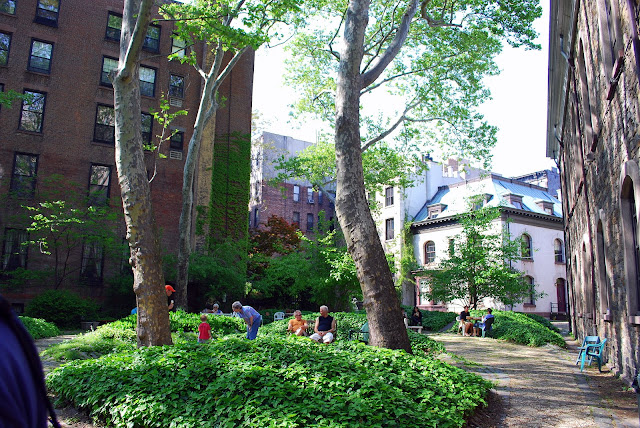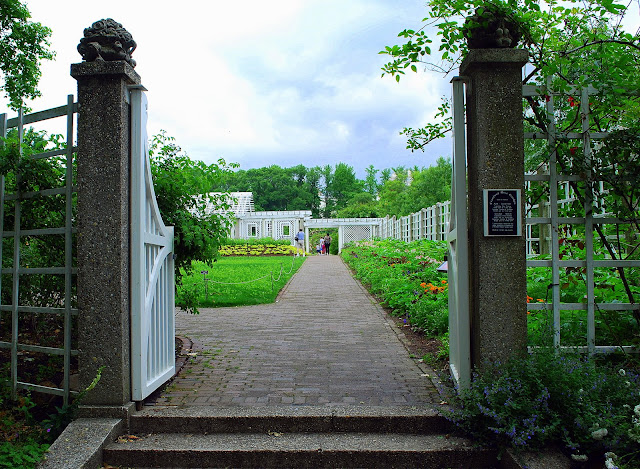
Look! Up in the sky! It's a bird! It's a plane! No, it's the "Antony Gormley's Event Horizon"!
OK, I couldn't resist that introduction, as I recently spent a whole afternoon looking up into the sky at building tops around Madison Square Park, located at 5th Avenue at 23rd Street in Manhattan, to view the Event Horizon art exhibit. If you look closely at the photo above you will see the images of a man on the top of three different buildings. You may have to enlarge the photo (and all photos) by clicking on it once and then again when it reopens on a new page. Can you see them?

I enlarged a section of the photo above so you can see the figure standing next to the water tower on top of one of the buildings. The Madison Square Park Conservancy is presenting the British artist Antony Gormley’s "Event Horizon," as a landmark public art exhibition, as part of Madison Square Art 2010. The exhibit runs March 26 through August 15, 2010.
Four life-size body forms of the artist cast in iron inhabit the sidewalks of historic Madison Square Park, as well as 27 fiberglass figures positioned on the rooftops of the many architectural treasures of New York’s vibrant Flatiron District. A map of all their locations can be seen on the Event Horizon web site.
Can you see the figure in front of The Empire State Building?
A closer view.
According to a brochure about the project, that was handed out in Madison Square Park, Gormley states:
"Event Horizon hopes to activate the skyline in order to encourage people to look around. In this process of looking and finding, or looking and seeking, one perhaps re-assess one's own position in the world and becomes aware of one's status of embedment."There was some controversy when this project was first initiated that people on the street, unaware of the art project, would fear that the figures were actual people; potential jumpers on the verge of committing suicide. For the most part this did not occur, as there was enough publicity before the installation of the figures to inform the public of what they were.
In a New York Times article Gormley states: "You could almost say the insertion of the sculpture is like the insertion of acupuncture needles within a collective body. And seeing how the body as a whole reacts to the presence of this irritation is very much the point.”
In a New York Times article Gormley states: "You could almost say the insertion of the sculpture is like the insertion of acupuncture needles within a collective body. And seeing how the body as a whole reacts to the presence of this irritation is very much the point.”
I actually enjoyed searching the buildings for figures, as did many around me who were also on a quest to see how many they could spot. I think most New Yorker's become immune to the splendor of the city around them and are basically walking head down trying to get from point A to point B with as little interruption as possible. An art installation such as this makes even the most rushed city dweller stop for a moment and look up, and perhaps see with new eyes what he or she has been passing countless times without notice.
Some figures were not easy to see, and it became almost a game to try to pick them out. Can you see the figure on the circa 1909, 700 foot high, landmarked Clock Tower that faces Madison Square Park?
Perhaps now you can see him in the corner of the terrace on the tower?
Even the iconic Flatiron Building had a figure peering over the edge.
Here it is at the very top.
This video shows Antony Gormley in the process of choosing the sites for the statues. I like the panorama of the city he had from the top of the Flatiron Building, and his statement that "Manhattan is a living laboratory of possibility of how human beings can live together."
It is definitely an unusual and eye opening art exhibit, and if you don't get a chance to see it personally, I hope you enjoyed my photographic selections of it.
It is definitely an unusual and eye opening art exhibit, and if you don't get a chance to see it personally, I hope you enjoyed my photographic selections of it.
I'm adding this post to the "Outdoor Wednesday" event on Susan's A Southern Daydreamer blog. Please look at Susan's blog on Wednesday to see the links of participating blogs with their fabulous outdoor posts.



































































